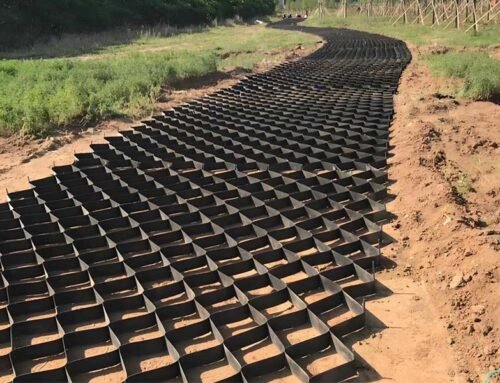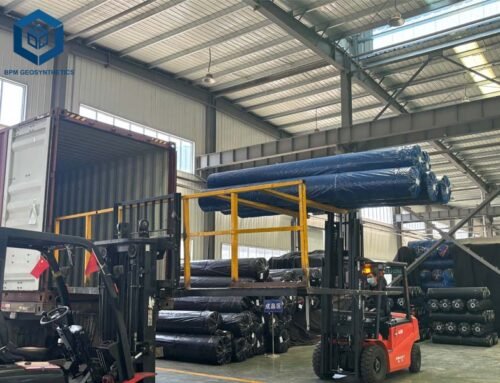Over the past decade, geomembranes have become increasingly popular in the mining industry. Our BPM HDPE Membrane Sheet has been installed in various mining projects around the world. With 20 years of experience in geotechnical engineering, we provide customers with high-quality products and professional mining installation experience. Next, BPM Geosynthetics will discuss the following aspects of HDPE Membrane Sheets as the best choice for mining projects.
1. What Is HDPE Membrane Sheet?
High-density polyethylene (HDPE) membrane sheet acts as a waterproof lining in modern mining. This plastic sheet creates an impermeable shield between soil and potential site chemicals or water. HDPE is used in tailings storage, waste ponds, and containment areas to isolate contaminants, safeguarding soil and groundwater. It also protects mineral processing facilities and boosts mining efficiency by minimizing water loss from evaporation and leakage. Noted for its strength, puncture, and chemical resistance, HDPE withstands harsh mining environments. Installation must be precise, including meticulous surface prep, leak-free seaming, and consistent maintenance for durability.


2. What Are Properties Of HDPE Membrane Sheet In Mining?
The properties of HDPE (High-Density Polyethylene) membrane sheets commonly used in mining applications include:
2.1 Chemical Resistance
HDPE membranes are resistant to a wide range of chemicals, making them suitable for mining environments with potentially corrosive substances.
2.2 Durability
HDPE membranes are durable and exhibit high tensile strength, allowing them to withstand the harsh conditions often found in mining operations.
2.3 UV Resistance
HDPE membranes are typically UV stabilized, which helps them maintain their integrity when exposed to sunlight, common in outdoor mining applications.
2.4 Flexibility
HDPE membranes are flexible and can conform to irregular surfaces, providing effective coverage and protection in mining operations.
2.5 Impermeability
HDPE membranes are impermeable to water and other liquids, making them ideal for applications where preventing leakage or seepage is crucial.
2.6 Temperature Resistance
HDPE membranes can withstand a wide range of temperatures, making them suitable for mining environments with varying thermal conditions.
2.7 Ease of Installation
HDPE membranes are relatively easy to install, which can be advantageous in mining projects where quick deployment is necessary.
2.8 Longevity
HDPE membranes have a long service life, providing lasting protection to mining structures and environments.
3. How To Choose Right HDPE Membrane Sheet For Mining Project?
Choosing the right high-density polyethylene (HDPE) membrane sheet for a mining project involves considering several factors to ensure the material meets the specific requirements and provides long-term performance. Here are some key steps and considerations:
3.1 Assess Site-Specific Conditions
Evaluate the chemicals, minerals, and waste materials that will come into contact with the liner. Consider factors such as pH levels, solvents, metals, and other contaminants.
3.2 Determine Thickness Needs
Choose a thickness appropriate for the type of mine, the expected load, and the lining system design. Thicker sheets may be required for more aggressive chemical environments or heavier loads.
3.3 Evaluate Durability
Ensure the HDPE membrane has sufficient puncture resistance, tear strength, and durability to withstand installation and the mining environment, including exposure to sharp objects and potential mechanical stresses.
3.4 Consider Chemical Resistance:
Select an HDPE membrane that is resistant to the specific chemicals present at the site. Some HDPE formulations offer enhanced resistance to particular chemicals or compounds.
3.5 UV Resistance
If the membrane will be exposed to sunlight, choose a material with UV stabilizers to prevent degradation over time.
3.6 Consult Manufacturer Specifications
Review the technical data provided by the manufacturer to understand the physical and chemical properties of the membrane.
3.7 Regulatory Compliance
Ensure that the selected material complies with local regulations and international standards relevant to the mining industry.
3.8 Installation Requirements
Consider the installation process, including welding techniques and equipment compatibility, to ensure proper seaming and placement.
3.9 Long-Term Performance
Evaluate the expected lifespan of the membrane and consider any available warranties or guarantees from the manufacturer.
3.10 Environmental Impact
Prefer materials that are recyclable and have a lower environmental footprint throughout their lifecycle.
3.11 Cost-Benefit Analysis
Weigh the costs against the benefits, taking into account the overall project budget and the long-term savings from potential leakage prevention.
3.12 Supplier Reputation
Choose a reputable supplier known for quality products and reliable customer service to ensure you receive high-quality material and support.
By carefully considering these factors, you can select an HDPE membrane sheet that is best suited for your mining project’s specific needs and conditions.


4. How To Install HDPE Membrane Sheet In Mining?
To install an HDPE (High-Density Polyethylene) membrane sheet in a mining project, follow these general steps:
4.1 Surface Preparation
- Ensure the surface is clean, smooth, and free of any sharp objects that could damage the membrane.
4.2 Unrolling the Membrane
- Unroll the HDPE membrane sheet carefully over the prepared surface, starting from one end and working towards the other.
4.3 Cutting and Seaming
- Cut the membrane to fit the dimensions of the area, leaving some excess material for overlap.
- Seam the pieces together using heat welding or other appropriate methods, ensuring a secure and watertight seal.
4.4 Anchoring and Securing
- Anchor the edges of the membrane using appropriate fasteners, such as stakes or screws, to keep it in place during installation and prevent shifting.
4.5 Testing for Leaks
- Conduct a leak test to ensure the membrane is properly installed and sealed. This can involve filling the area with water and checking for any leaks.
4.6 Covering and Protection
- Once the membrane is installed and tested, cover it with the appropriate fill material, such as soil or rock, to protect it from damage and provide additional stability.
4.7 Quality Check
- Inspect the entire installation to ensure there are no tears, punctures, or gaps in the membrane that could compromise its effectiveness.
4.8 Maintenance and Monitoring
- Implement a regular maintenance schedule to inspect the membrane for any signs of damage or wear and address any issues promptly to maintain its integrity.
By following these steps and ensuring proper installation techniques, you can effectively install an HDPE membrane sheet in a mining project to provide containment, protection, and stability as required in mining applications.
5. Summary
Choosing the right high-density polyethylene (HDPE) membrane sheet for a mining project is a critical decision that requires careful consideration of multiple factors. By understanding the specific chemical, physical, and environmental demands of your mining operation, you can select an HDPE membrane that ensures the long-term success and sustainability of your lining system. Remember to consider chemical resistance, thickness, durability, UV resistance, weldability, and compliance with regulations. Evaluate the reputation and expertise of potential suppliers to guarantee you receive high-quality materials and reliable support. With the right HDPE membrane sheet in place, you can protect against pollution, meet environmental standards, and maintain the integrity of your mining operations. Investing time in this selection process will ultimately save you from costly repairs or replacements and ensure the protection of your mine site and the surrounding environment. If you have any further questions, please feel free to contact us.





